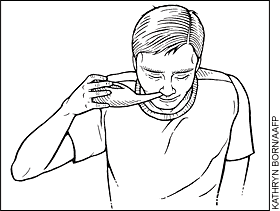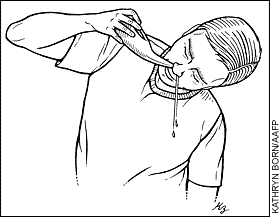
Am Fam Physician. 2009;80(10):1121-1122
See related article on saline nasal irrigation.
What is saline nasal irrigation?
This therapy rinses your nasal cavity, the area behind your nose, with salt water (saline). You can do it at home to help with your sinus problems, such as a stuffy or runny nose.
How do I do it?
You can use a nasal cup, also known as a neti pot, and nasal saline salt packs. You can get these at many pharmacies. To use a nasal cup, follow three steps:
Mix the solution. Follow the directions on the salt package to make salt water using lukewarm water. Put 4 fl oz (100 mL) of the solution in the nasal cup.
Position the nasal cup. Lean over the sink so you are looking down into the basin. Turn your head slightly to one side, and gently put the spout of the nasal cup into your upper nostril so that it forms a comfortable seal. Do not press the spout against the middle part (septum) of your nose.
Pour the solution. Tip the nasal cup so that the solution pours into your upper nostril. Make sure to breathe through your mouth. The solution will soon drain out of your other nostril (see drawings). When the cup is empty, breathe out through both nostrils to clear out extra salt water and mucus. Gently blow your nose into a tissue. Then, repeat the process in the other nostril.
A variety of squirt and spray bottles are also available for nasal irrigation.


How often should I do it?
Start with one irrigation per day while you have symptoms. If you feel better, you may want to do it twice a day as part of your regular routine. Some patients use it to prevent sinus problems even when they don't have symptoms.
How will I feel afterward?
It is normal for drops of water to occasionally drain from your nose for up to 30 minutes after irrigation. You may want to carry tissues with you. If your nose stings or burns, try using half as much salt next time. You may also want to try a different water temperature. Do not use very hot or very cold water. You can also try nasal irrigation while you are in the shower.
How do I clean the nasal cup?
Always rinse out the extra salt water and wash the nasal cup with soap and water after using it. Most nasal cups are dishwasher safe. When you want to use the cup again, mix a fresh salt water solution.
Where can I get more information?
Your doctor
University of Wisconsin Department of Family Medicine